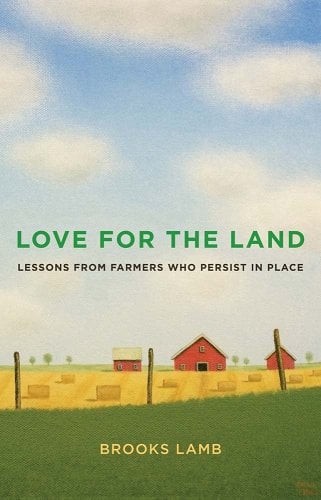Oxford, MS. The “New Agrarianism” still rests on the rockiest of soils in the “New South.” In spite of the rich stratum of writers that stretches from John Crowe Ransom, Robert Penn Warren, and Richard Weaver to Wendell Berry, bell hooks, and Nikky Finney, the values (and the value) of the land across the region are as riddled as ever with the same old fieldstones of “industrialism,” “materialism,” and racism that these authors have ploughed up (or, for others of the “Twelve Southerners,” ploughed around) since the Second World War. It is not until the last decade that a more recent generation of authors, artists, and activists as well as a much-needed revaluation of the work of Ransom, Berry, and hooks has come together in an effort to clear the ground for a proper conversation about the relationship between people and land in the American South.
It is within this effort that we should see the life and work of Brooks Lamb. As a Truman Scholar with a BA from Rhodes College and an MA from the Yale School of the Environment, Lamb has written a number of articles for publications like Modern Farmer, The Daily Yonder, and AGDAILY, and, as a Land Protection and Access Specialist at the American Farmland Trust, he has written or underwritten a number of actions for the protection of farmland with the USDA. As the son of a long line of small farmers from Marshall County, Tennessee, too, he has worked a number of hours in fields and pastures like the ones still found across the Volunteer State, the South, and the U.S. In Love for the Land: Lessons from Farmers Who Persist in Place, Lamb brings all the skills from all these experiences to bear in a raw, beautiful, and inspiring exploration of the power and the potential of the relationship between people and the land in the face of consolidation, suburbanization, discrimination, and the other trends that continue to threaten it across the U.S.
In the Preface and in Chapter One on “The Virtues of Imagination, Affection and Fidelity,” Lamb sets out the methodological premise and the “philosophical foundation” of the book with reference to the work of Berry, hooks, Norman Wirzba, and other “New Agrarians” as well as his own experiences as an “amateur ethnographer” in Marshall, Robertson, and Maury Counties. Love for the Land thus starts from a set of definitions and a series of distinctions among the “stewardship virtues” that will be familiar to readers of FPR, but, from the first page, the book also shines, with an uncommon brightness, in the excerpts that the author shares from his interviews with farmers across Tennessee, such is this one, from Hal in Holts Corner:
I am the only one on God’s green earth who knows where each buried rock that can hang a plow is located, where the wet spots are that should be left alone until dry weather, where the six wells are (some hidden now from disuse), where the best fishing hole in the creek to catch perch is, where all the family pets are buried, where the big weeping willow was in the yard, where the old cabin was located, where the old Jersey cow with the new-born calf “wallered” me in the ground when I was a six year old boy, and all those places and times my parents and grandparents taught me to love this land (xii-xiii).
From here, and in Chapters Two, Three, and Four, Lamb presents the case of Robertson County, a place whose farmland, located between Clarksville and Nashville, is more menaced than most by the threats of conversion (into suburbs, strip malls, and industrial parks) and consolidation that farmers face across Tennessee, the South, and the U.S. Indeed, from Lamb, we learn that, in Robertson County, the farmland area fell over 40,000 acres, or almost 3,000 per year and 7.5 per day, from 2002 to 2017, a trend that can now be found and followed in the USDA Census of 2022.
With the sense of a small farmer as well as the skills of a seasoned ethnographer, Lamb then cuts through and lays bare these problems, their causes, and their consequences on the land and the lives of his subjects, with an eye to the role of subsidies as well as sprawl or the general loss of farm stores and repair businesses as well as generational turnover, in Robertson County. Still, it is here that the author finds the farmers who, through their presence (and their refusal of the hundreds of thousands that developers offer them for their land), provide the “lessons” on how to persist and, perhaps, with some support, to prosper, that are at the heart of Love for the Land.
It is in his second case, and in Chapters Five and Six, however, that Lamb finds the interviewees who furnish the even harder lessons of how to “persist in place,” in the farmers and, above all, the Black farmers, of Maury County, who have fought the series of “systemic struggles” against the discrimination of financial institutions, the federal government, and their fellow citizens that Black Americans have faced across the US as well as the same issues of consolidation and suburbanization that farmers have faced in Robertson Country. For this case, Lamb draws, once more, on his depth of experience with the AFT, for a critical examination of the problems, the solutions and the problems with the solutions for this community, above all, the problems with the heirs’ property, in which families, often for lack of access to legal services, will sign on to this form of common ownership, but to find themselves at the mercy of massive loopholes through which developers can force a sale at a public auction, and, in turn, force these families off of their land. Together with the broad processes of the industrialization of agriculture across Tennessee, the South and the U.S., such practices create a situation in which, and in the words of Walter from Maury County, “The little farmer—white, Black, indifferent—they’re struggling” (146).
To that end, in Chapter Seven, “Leveraging Love for the Land,” Lamb concludes with what we often lack in critiques of agriculture in the U.S, and that is, a set of solutions, with a nod to private initiative and the practice of “stewardship virtues” across Tennessee, the South and the U.S. as well as public injunctions like the Agricultural Conservation Easement Program, the Uniform Partition of Heirs’ Property Act and the Office of Small Farms. Lamb thus fulfills his promise to follow imagination, affection, and fidelity “from philosophy to practice to policy” and, in the end, he shows us how, in his own words, “Heeding lessons from farmers who persist in place, we can embrace these virtues. Rather than give up or get out, we can dig in. Rather than go big, we can go home. For the sake of people, place and the planet, we should live with love for the land” (199).
All in all, Love for the Land, taken together with the beautiful printing and the reasonable price that we have come to expect from the Agrarian Studies Series at Yale University Press, does indeed deserve a place on the nightstand of Porchers, but it also merits consideration as a foundational text for the “New Agrarianism” in the South and across the U.S.









1 comment
Brian Miller
This looks like it will be a solid addition to the agrarian shelf. I look forward to getting a copy and reading it.
Comments are closed.